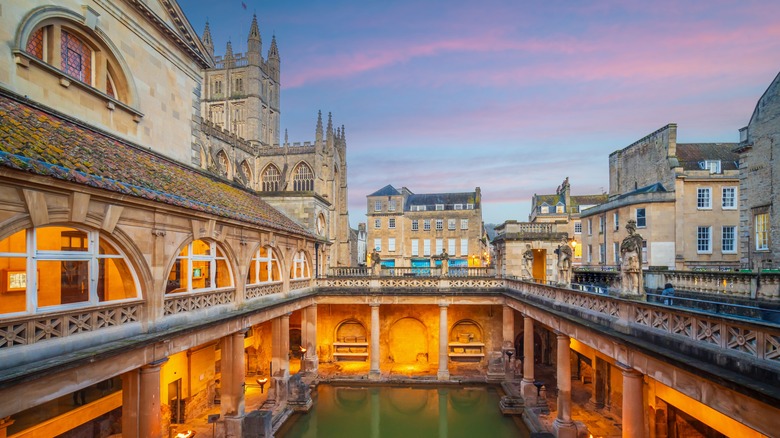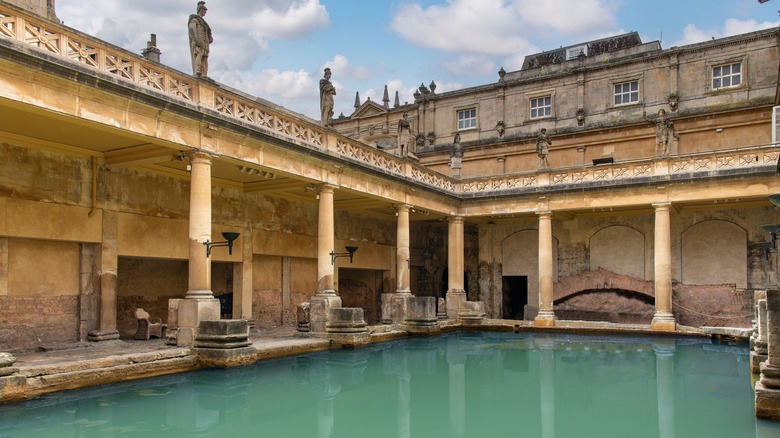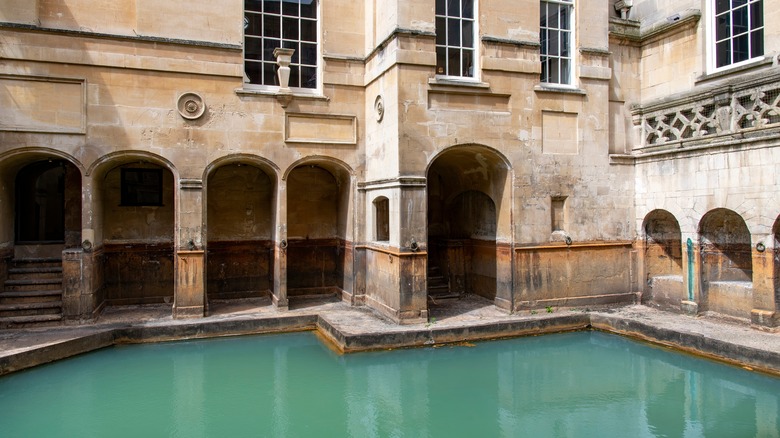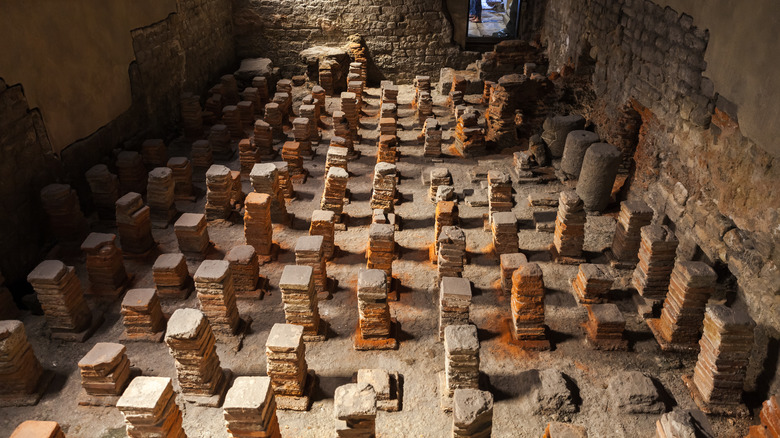A UNESCO World Heritage Site Is One Of The Best-Preserved Ancient Roman Bath Complexes In Europe
Despite being nearly 2,000 years old, the baths in England still have their intricate Roman architecture and engineering intact. As one of the best-preserved complexes of its kind, this iconic attraction is so integral to Bath's identity that the city itself is named after it. The English city of Bath shines with history, luxury, and timeless charm, and the stunning Roman baths serve as its centerpiece.
Getting to Bath is fairly straightforward, whether you're traveling from London, nearby cities, or even farther afield. If you're taking a train from London, you can reach the city in about an hour and a half — it's the quickest way to get there. Driving from the capital takes a bit longer, anywhere between two and a half to three hours, depending on traffic — the M4 motorway is the best route. However, if you've skipped the hustle and bustle of London and opted for the beautiful, vibrant, and less crowded city of Liverpool, pack some snacks and expect to enjoy the English countryside. The drive to Bath can take up to four hours from Liverpool with a pitstop in Birmingham, so plan the road trip of your dreams accordingly. For those coming from Cardiff, the drive is shorter; it'll take you around an hour and a half. A train also runs from Cardiff to Bath. And if you're based in Bristol, you're even closer — you'll get to Bath in 50 minutes — 10 if you take British Railways. No matter how long your journey is, rest assured that exploring this incredible historical monument makes it worthwhile.
The catch is, you can't bathe in the Roman baths. They might be filled with water, but the quality is not considered safe to bathe in. Instead, head to the nearby Thermae Bath Spa, which uses the same water but treats it first.
Bath has been attracting spa-goers since Roman Britain
Built around 70 AD, the Roman bath complex was the heart of leisure, where 1.17 million liters of spring water flowed on a daily basis. During the Roman times, precision was a major priority. They built the baths atop oak piles, created stone chambers, and even divided the venue into different sections — from hot baths to cold dips. But not all was perfect at this incredible facility — even wellness enthusiasts of the time left bad reviews. Archeologists found over 130 curse tablets that revealed complaints from bathers who had their clothes stolen — even in antiquity, petty crime was very much a local concern.
As time passed, the spa fell into disrepair after the Romans left in the 5th century. But against all odds, the appeal of the hot springs never faded away. By the 12th century, the baths were revived, and even Queen Anne of Denmark herself indulged in the healing waters during the early 1600s. In fact, her visit inspired the addition of the New Bath, with a crowned column engraved with "Anna Regnum Sacrum."
By the 18th century, Bath's Roman heritage got a fresh lease on life, all thanks to the creative genius of architects John Wood the Elder and his son, John Wood the Younger. They brought a touch of Neoclassical splendor to the city, surrounding the natural springs with sophisticated structures. The city of Bath earned its UNESCO World Heritage Site status in 1987 — 19 centuries after the thermae was first constructed.
Relive history at the Sacred Spring and the Roman Temple
Your first impression of the Roman Baths is from the lavish terrace, with Victorian-era statues of Roman leaders guarding the Great Bath below. Situated below today's street level, the spa center consists of the Sacred Spring, the Roman Temple, the Roman Bath House, and the museum. When you visit this historical landmark, the first place you'll want to see is the Sacred Spring. Flowing from the Temple of Sulis Minerva's courtyard, this spring has been considered a blessed site for centuries. What's more, the extension into the water points to its religious significance long before the Roman invasion.
Not far from the Sacred Spring, you'll come across the King's Bath, which was constructed in the 12th century using the lower walls of the original structure. Also known as the Great Bath, this is perhaps the biggest draw of the establishment. The chamber featured alcoves where patrons could soak in the therapeutic waters. This large pool has steps on all sides for easy access, with a depth of over 5 feet of steaming hot water. You'll also notice the diving stone on the side, where hot water feeds into the pool. As you stroll the area, you'll encounter changing rooms and saunas where guests used to prepare for their treatments. This quarter includes a tepid bath and heated rooms — there are also projections and sounds that recreate the scenes of how people once interacted with each other.
Walk through the Roman Temple and step into the past
The Roman Temple is another highlight of the premises that you have to check out. Dedicated to the goddess Sulis Minerva, this zone was the spiritual hub of ancient Bath. Even though you can only stand in what's left of the temple, its prime was as grand as you could imagine. It once boasted towering columns, a grand staircase, and a sacred space where rituals took place. The temple, built in the late first century, was designed with impressive Corinthian columns and a large frieze. As the centuries wore on, Christianity spread and the temple fell into ruin. Fragments of the pediment were then repurposed as paving stones in the courtyard.
The western section of the Roman Baths is where the cold plunge pools and more heated rooms are located. The short films on the walls show you how wellness devotees used these pools back in the day. On your tour, you'll view a large collection of Roman relics and mementos, many of which were cast into the Sacred Spring for spiritual reasons. Among these are over 12,000 Roman coins — the largest known collection of its kind in Britain. But it's the bronze head of Sulis Minerva that'll catch your attention. Discovered in 1727, this is the only piece left from the original full statue. At the end of your visit, don't miss the chance to taste the famous spa water, rich in 43 minerals. Before you leave the city, be sure to check out romantic "Bridgerton" filming locations at the Royal Crescent.



